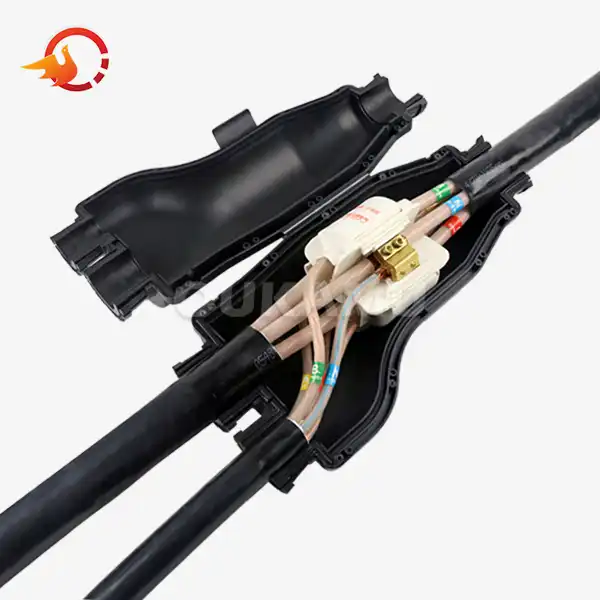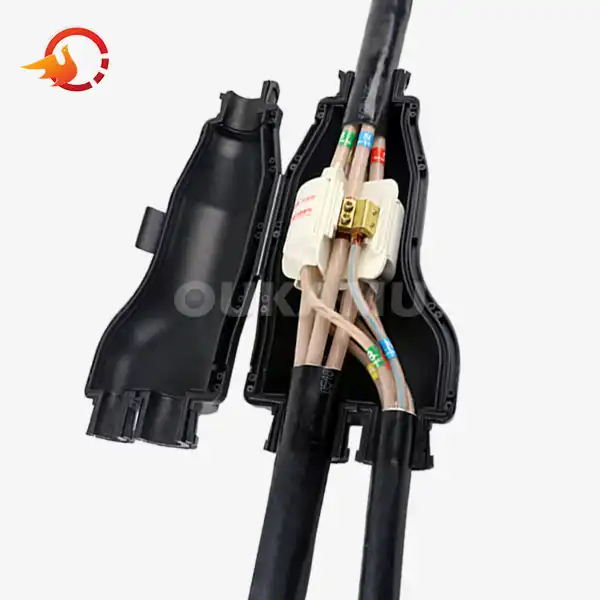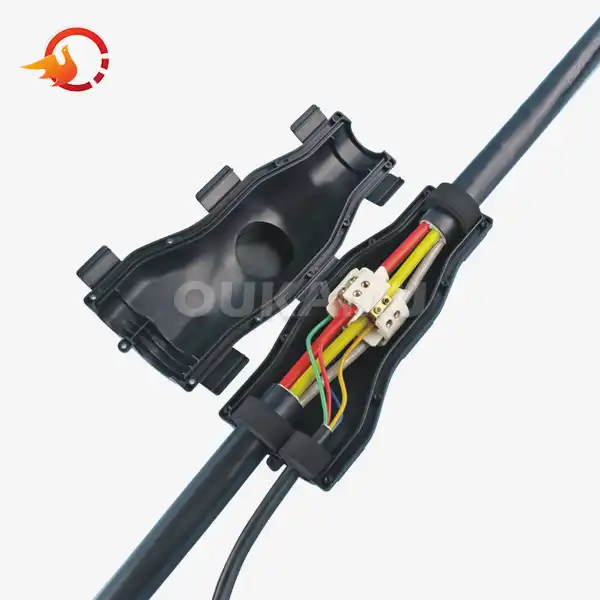How to Fix Air Bubbles in Cable Joint Resin for a Clean Seal?
 2025-06-13 16:02:59
View:389
2025-06-13 16:02:59
View:389Air bubbles in cable joint resin can compromise the integrity of your electrical connections, potentially leading to safety hazards and reduced performance. As experts in cable connection products, we understand the importance of achieving a clean, bubble-free seal. In this comprehensive guide, we'll explore effective techniques to eliminate air bubbles and ensure a flawless resin application for your cable joints.
Understanding the Impact of Air Bubbles in Cable Joint Resin
Before delving into solutions, it's crucial to grasp why air bubbles pose such a significant problem in cable joint resin applications. Air bubbles can:
- Compromise the insulation properties of the resin
- Create weak points susceptible to moisture ingress
- Reduce the overall mechanical strength of the joint
- Increase the risk of electrical breakdown under high voltage stress
These issues can lead to premature failure of the cable joint, potentially causing power interruptions, equipment damage, or even safety hazards. Therefore, achieving a bubble-free resin seal is paramount for ensuring the longevity and reliability of your cable connections.
Common Causes of Air Bubbles in Resin Applications
To effectively address air bubble formation, it's essential to understand their origins. Some common causes include:
- Improper mixing of resin components
- Rapid pouring or application of the resin
- Inadequate preparation of the cable joint surface
- Environmental factors such as high humidity or temperature fluctuations
- Use of low-quality or expired resin products
By identifying these potential sources, you can take proactive measures to minimize the risk of air bubble formation during the resin application process.
Proven Techniques for Eliminating Air Bubbles in Cable Joint Resin
Now that we've established the importance of bubble-free resin applications, let's explore some effective methods to achieve this goal:
Proper Mixing and Degassing
One of the most critical steps in preventing air bubbles is ensuring thorough mixing and degassing of the resin components:
- Use a high-quality mixing tool, such as a paddle mixer or a specialized resin mixer, to blend the components evenly
- Mix at a slow, consistent speed to minimize air entrapment
- After mixing, allow the cable joint resin to sit for a few minutes to allow larger air bubbles to rise to the surface
- Consider using a vacuum chamber to remove trapped air from the mixed resin before application
Controlled Pouring Techniques
The way you pour the resin into the cable joint can significantly impact bubble formation:
- Pour the resin slowly and steadily, allowing it to flow naturally into all crevices
- Use a thin stream or "ribbon" pouring technique to minimize air entrapment
- Consider using a funnel or specialized pouring tool to maintain a controlled flow
- Pour the resin at an angle, allowing it to cascade down the side of the joint rather than falling directly onto the surface
Environmental Control and Material Preparation
Creating optimal conditions for resin application can help reduce the likelihood of air bubble formation:
- Ensure the work area is clean, dry, and free from dust or debris
- Control the ambient temperature and humidity to match the resin manufacturer's recommendations
- Preheat the cable joint components to the specified temperature, if required
- Thoroughly clean and prepare the cable joint surfaces, removing any contaminants that could interfere with resin adhesion
Post-Application Bubble Removal Techniques
Even with careful preparation and application, some bubbles may still form. Here are some methods to address them:
- Use a heat gun or torch to gently warm the surface of the resin, encouraging bubbles to rise and pop
- Employ a vibration technique, such as tapping the mold or using a vibrating tool, to help bubbles rise to the surface
- For smaller joints, consider using a pressure pot to apply uniform pressure during curing, forcing bubbles to dissolve back into the resin
Advanced Solutions for Persistent Air Bubble Issues
For particularly challenging applications or when dealing with high-voltage cable joint resin, more advanced techniques may be necessary:
Vacuum Potting Systems
Vacuum potting involves applying the resin under vacuum conditions, effectively eliminating air bubbles before they can form:
- The cable joint is placed in a vacuum chamber
- Air is evacuated from the chamber, creating a vacuum
- Resin is introduced into the joint under vacuum, ensuring complete filling without air entrapment
- Pressure is gradually returned to atmospheric levels, further compressing any remaining micro-bubbles
This method is highly effective but requires specialized equipment and is typically reserved for critical applications or high-volume production environments.
Centrifugal Casting
For certain types of cable joints, centrifugal casting can be an effective way to eliminate air bubbles:
- The cable joint mold is mounted on a centrifuge
- Resin is introduced while the mold is spinning at high speed
- Centrifugal force pushes the resin outward, forcing air bubbles towards the center where they can be easily removed
This technique is particularly useful for cylindrical or symmetrical joint designs but requires specialized equipment and careful process control.
Pressure Injection Systems
Pressure injection systems use positive pressure to force resin into the cable joint, minimizing the chances of air entrapment. This method, often enhanced by jointing technologies, ensures optimal sealing and efficient filling of the joint. The process works as follows:
- The resin is loaded into a pressurized reservoir
- The cable joint is sealed within a mold or containment system
- Resin is injected under pressure, filling all voids and forcing out any trapped air
This method is effective for complex joint geometries and can be automated for high-volume production.
Incorporation of Degassing Additives
Some advanced resin formulations include degassing additives that help eliminate air bubbles during the curing process:
- These additives work by lowering the surface tension of the resin
- Air bubbles are more easily released from the mixture
- The additives may also promote the coalescence of smaller bubbles into larger ones that rise to the surface more quickly
When selecting a resin system for your cable joint application, inquire about formulations that include these specialized degassing agents.
Conclusion
Achieving a bubble-free cable joint resin application is critical for ensuring the long-term reliability and safety of electrical connections. By understanding the causes of air bubbles and implementing the techniques outlined in this guide, you can significantly improve the quality of your cable joint installations. Remember that the specific method you choose may depend on factors such as the type of cable, environmental conditions, and production volume.
At Xi'an Oukamu Electric Co., Ltd., we specialize in providing advanced cable connection solutions that prioritize safety, reliability, and ease of installation. Our cable joint products are designed to minimize the risk of air bubble formation while offering superior electrical and mechanical properties. For more information about our innovative cable connection technologies or for personalized advice on your specific application, please don't hesitate to contact us at info@okmbranchcable.com.
References
1. Zhang, L., & Li, Y. (2019). Advances in cable joint resin technology for high voltage applications. IEEE Transactions on Dielectrics and Electrical Insulation, 26(3), 768-777.
2. Smith, R. J., & Johnson, T. K. (2020). Optimizing resin application techniques for improved cable joint reliability. Electrical Power Systems Research, 185, 106368.
3. Brown, A. C., et al. (2018). Impact of air voids on the long-term performance of medium voltage cable joints. IEEE Electrical Insulation Conference (EIC), 31-34.
4. Takahashi, H., & Yamada, M. (2021). Novel degassing methods for epoxy resins used in high voltage cable accessories. Polymers for Advanced Technologies, 32(5), 2021-2032.
5. García-Hernández, M., et al. (2017). Influence of processing parameters on void formation in epoxy resin for electrical insulation applications. IEEE Transactions on Dielectrics and Electrical Insulation, 24(2), 1080-1087.















